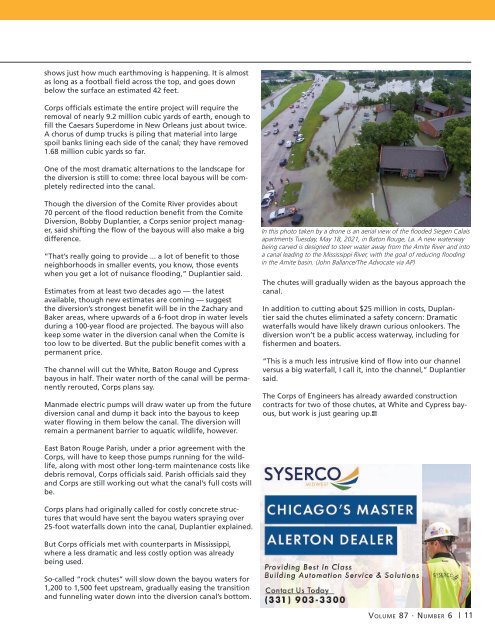CEAC-2022-06-June
You also want an ePaper? Increase the reach of your titles
YUMPU automatically turns print PDFs into web optimized ePapers that Google loves.
shows just how much earthmoving is happening. It is almost<br />
as long as a football field across the top, and goes down<br />
below the surface an estimated 42 feet.<br />
Corps officials estimate the entire project will require the<br />
removal of nearly 9.2 million cubic yards of earth, enough to<br />
fill the Caesars Superdome in New Orleans just about twice.<br />
A chorus of dump trucks is piling that material into large<br />
spoil banks lining each side of the canal; they have removed<br />
1.68 million cubic yards so far.<br />
One of the most dramatic alternations to the landscape for<br />
the diversion is still to come: three local bayous will be completely<br />
redirected into the canal.<br />
Though the diversion of the Comite River provides about<br />
70 percent of the flood reduction benefit from the Comite<br />
Diversion, Bobby Duplantier, a Corps senior project manager,<br />
said shifting the flow of the bayous will also make a big<br />
difference.<br />
“That’s really going to provide ... a lot of benefit to those<br />
neighborhoods in smaller events, you know, those events<br />
when you get a lot of nuisance flooding,” Duplantier said.<br />
Estimates from at least two decades ago — the latest<br />
available, though new estimates are coming — suggest<br />
the diversion’s strongest benefit will be in the Zachary and<br />
Baker areas, where upwards of a 6-foot drop in water levels<br />
during a 100-year flood are projected. The bayous will also<br />
keep some water in the diversion canal when the Comite is<br />
too low to be diverted. But the public benefit comes with a<br />
permanent price.<br />
The channel will cut the White, Baton Rouge and Cypress<br />
bayous in half. Their water north of the canal will be permanently<br />
rerouted, Corps plans say.<br />
Manmade electric pumps will draw water up from the future<br />
diversion canal and dump it back into the bayous to keep<br />
water flowing in them below the canal. The diversion will<br />
remain a permanent barrier to aquatic wildlife, however.<br />
In this photo taken by a drone is an aerial view of the flooded Siegen Calais<br />
apartments Tuesday, May 18, 2021, in Baton Rouge, La. A new waterway<br />
being carved is designed to steer water away from the Amite River and into<br />
a canal leading to the Mississippi River, with the goal of reducing flooding<br />
in the Amite basin. (John Ballance/The Advocate via AP)<br />
The chutes will gradually widen as the bayous approach the<br />
canal.<br />
In addition to cutting about $25 million in costs, Duplantier<br />
said the chutes eliminated a safety concern: Dramatic<br />
waterfalls would have likely drawn curious onlookers. The<br />
diversion won’t be a public access waterway, including for<br />
fishermen and boaters.<br />
“This is a much less intrusive kind of flow into our channel<br />
versus a big waterfall, I call it, into the channel,” Duplantier<br />
said.<br />
The Corps of Engineers has already awarded construction<br />
contracts for two of those chutes, at White and Cypress bayous,<br />
but work is just gearing up.<br />
East Baton Rouge Parish, under a prior agreement with the<br />
Corps, will have to keep those pumps running for the wildlife,<br />
along with most other long-term maintenance costs like<br />
debris removal, Corps officials said. Parish officials said they<br />
and Corps are still working out what the canal’s full costs will<br />
be.<br />
Corps plans had originally called for costly concrete structures<br />
that would have sent the bayou waters spraying over<br />
25-foot waterfalls down into the canal, Duplantier explained.<br />
But Corps officials met with counterparts in Mississippi,<br />
where a less dramatic and less costly option was already<br />
being used.<br />
So-called “rock chutes” will slow down the bayou waters for<br />
1,200 to 1,500 feet upstream, gradually easing the transition<br />
and funneling water down into the diversion canal’s bottom.<br />
Volume 87 · Number 6 | 11


















